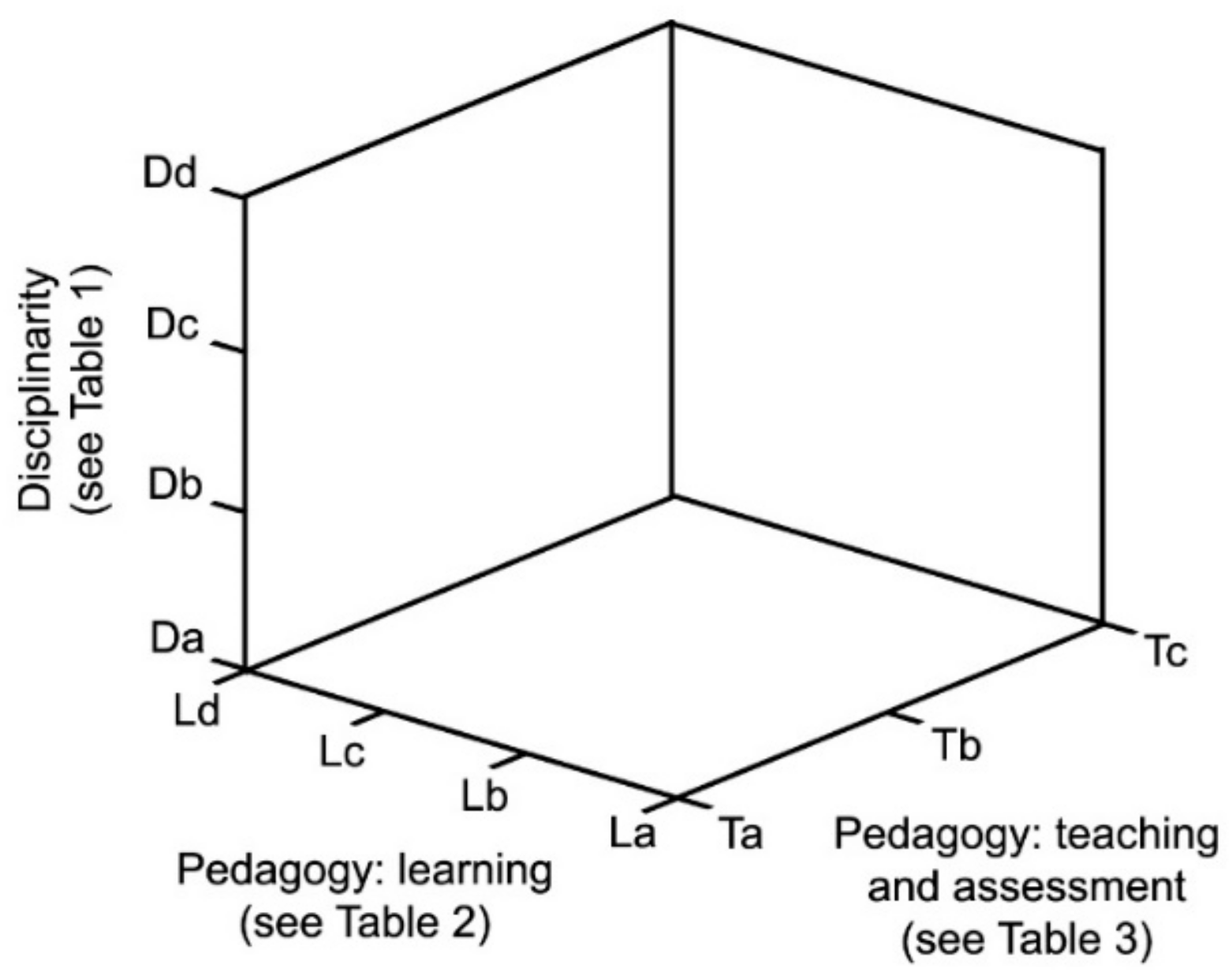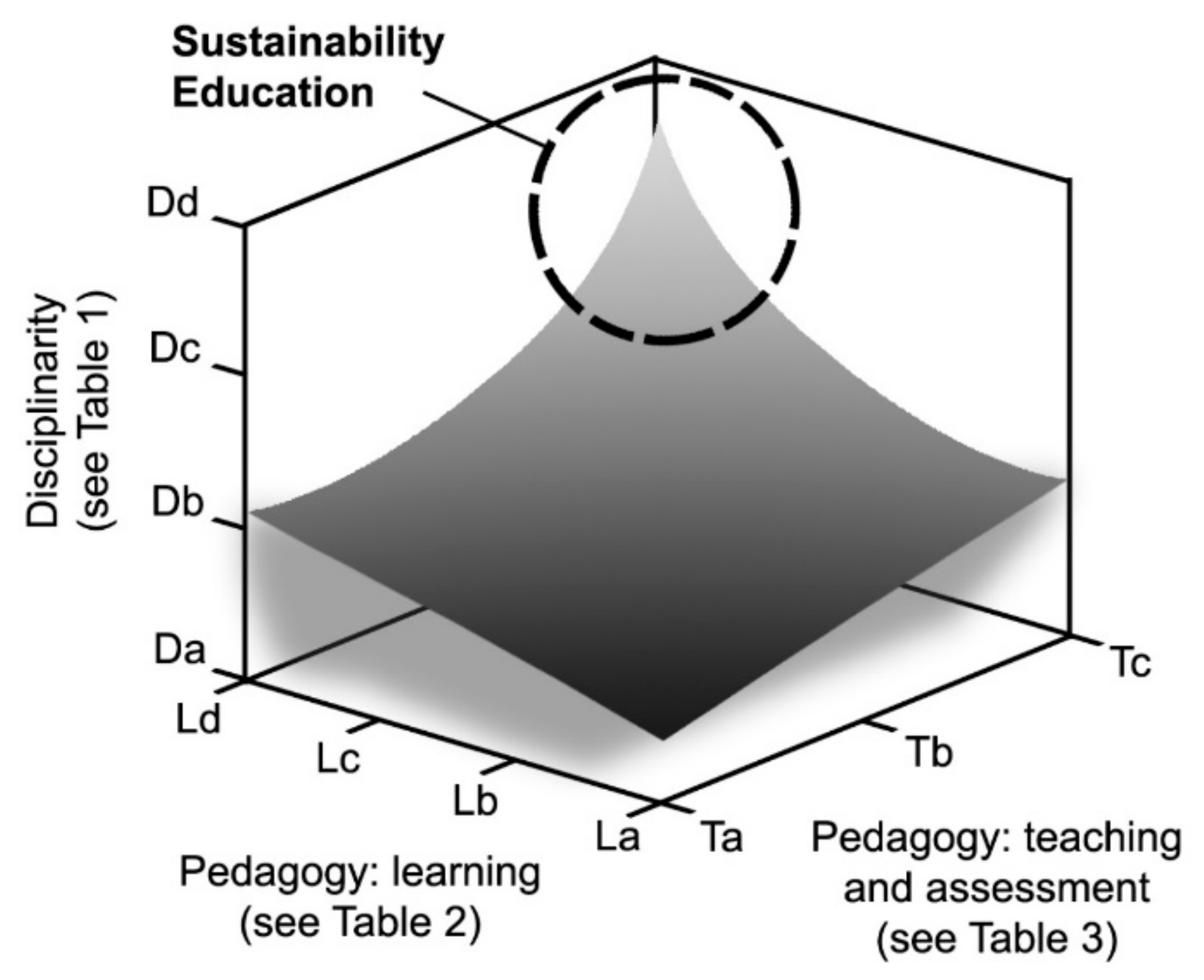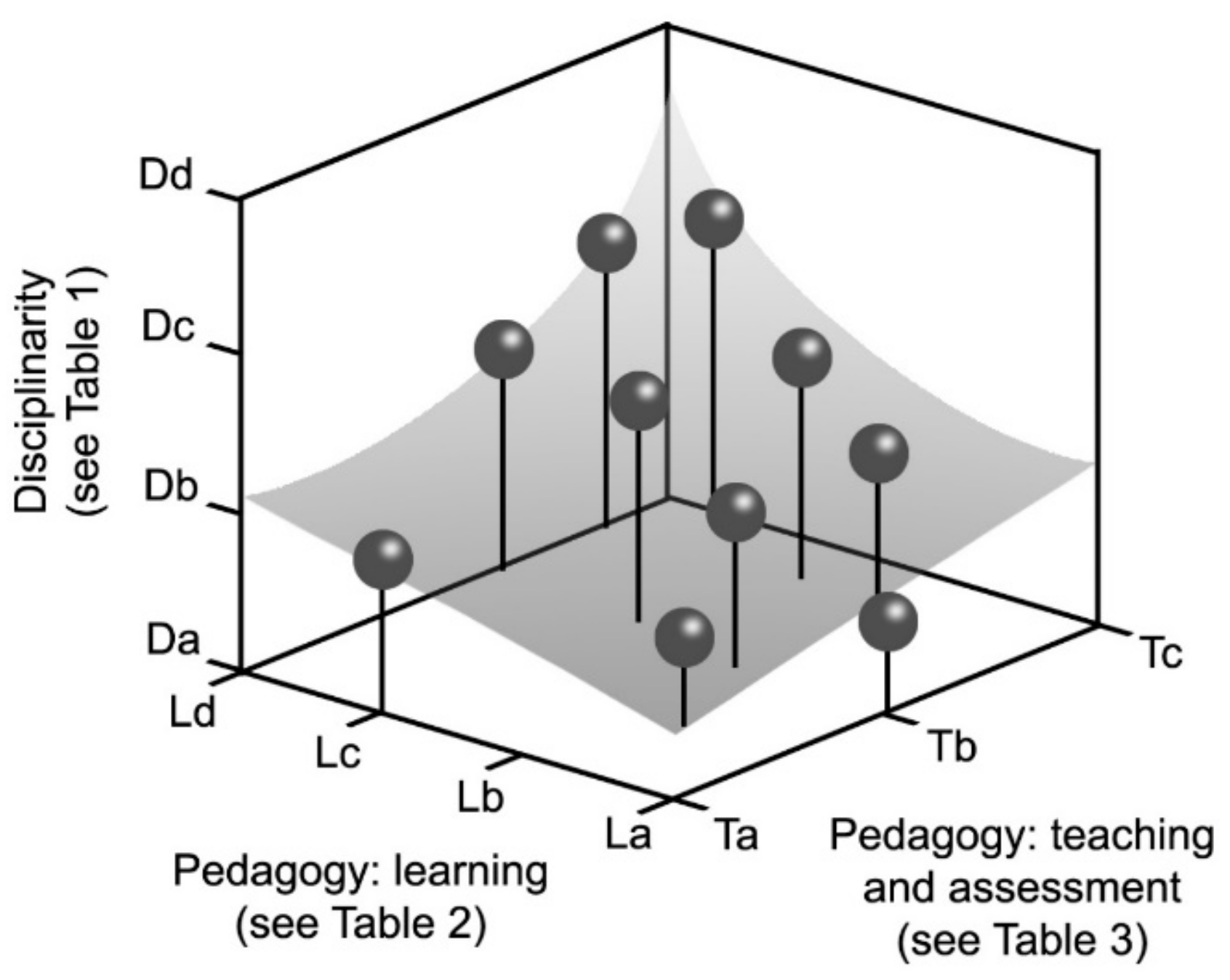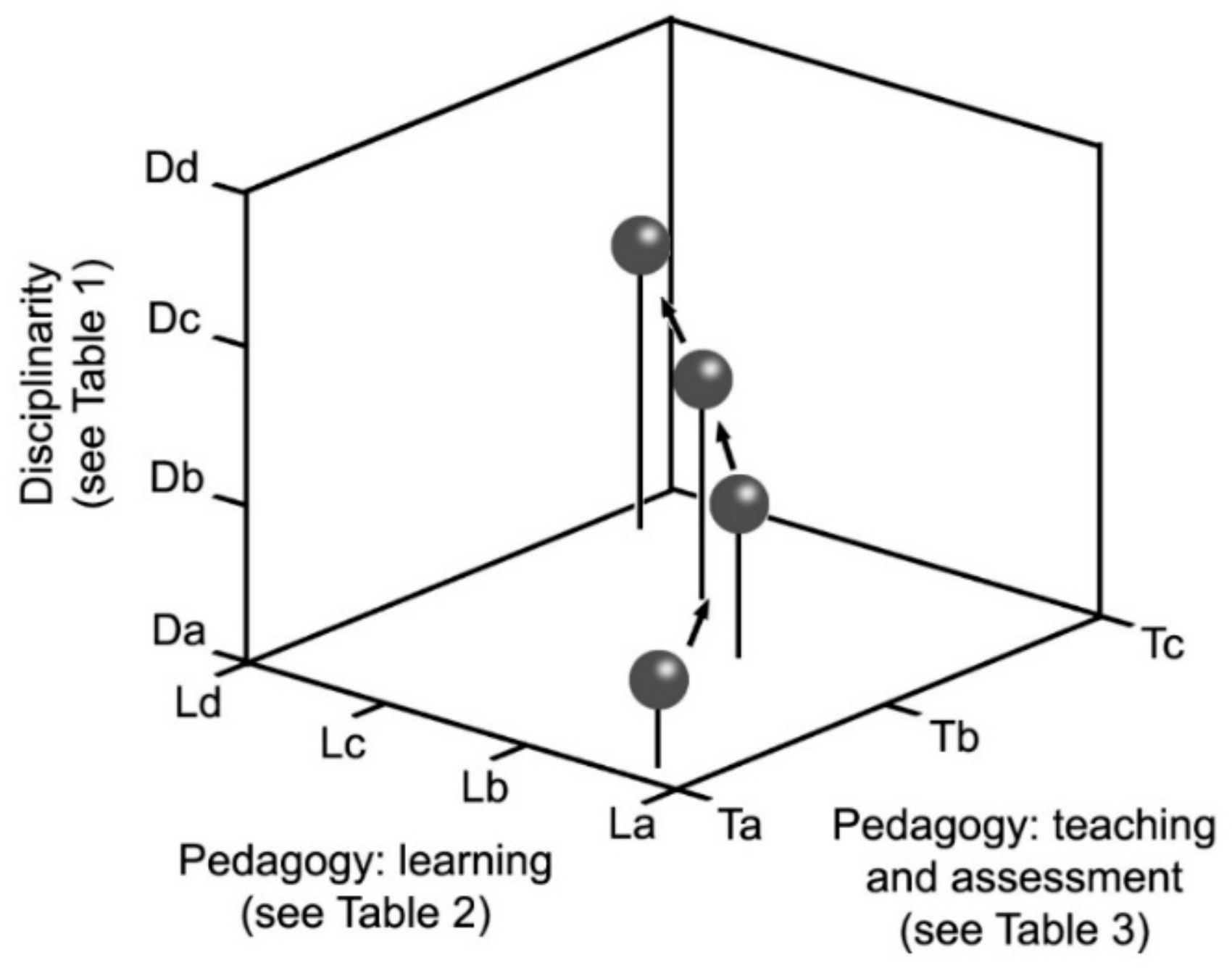Mapping Students’ Development in Response to Sustainability Education: A Conceptual Model
Abstract
1. Introduction
- Learning content: Specifically, the need for students and teaching staff to work across and between a range of academic disciplines, and to bring these together in a systems approach to address the complexity of global sustainability challenges.
- Pedagogy and the learning environment—the ways that learners learn: Sustainability learning must be about making use of knowledge and acquiring skills, rather than the delivery of largely factual or practical knowledge about specific subjects or preconceived ‘solutions’.
- Pedagogy and the learning environment—the ways that learners are taught and assessed: In order to support students as learners in a sustainability context, teaching and assessment need to be aligned to the nature of sustainability education.
2. Conceptual Basis
2.1. Content: ‘Disciplinarity’ and Systems Thinking.
2.2. Pedagogy and the Learning Environment: Ways of Learning
2.3. Pedagogy: Ways that Learners are Taught and Assessed
3. A Pedagogic Framework
Using the Framework as a Space to Describe Learning Objectives and Outcomes
4. A Learning Journey?
5. Reflection and Conclusions
- Employers place emphasis on transferable skills in addition to, or even over, academic mastery [59];
- Successful graduates are likely to move through several different employment rôles, some or most of which will not relate specifically to the subject of their degree;
- Subject boundaries are blurred, new subject areas are emerging, and subject specialisms are developing from the fusion of different fields with different cultures (for instance within biotechnology where ‘classical’ bioscience and data science are fusing).
How Can We Use the Model?
Author Contributions
Funding
Conflicts of Interest
References
- Howlett, C.; Ferreira, J.A.; Blomfield, J. Teaching sustainable development in higher education: Building critical, reflective thinkers through an interdisciplinary approach. Int. J. Sustain. High. Educ. 2016, 17, 305–321. [Google Scholar] [CrossRef]
- Shephard, K. Higher education for sustainability: Seeking affective learning outcomes. Int. J. Sustain. High. Educ. 2008, 9, 87–98. [Google Scholar] [CrossRef]
- Sterling, S. Higher Education, Sustainability, and the Role of Systemic Learning. In Higher Education and the Challenge of Sustainability; Corcoran, P.B., Wals, A.E.J., Eds.; Springer: Dordrecht, The Netherlands, 2004. [Google Scholar]
- Corcoran, P.B.; Weakland, J.P.; Wals, A.E. (Eds.) Envisioning Futures for Environmental and Sustainability Education; Academic Publishers: Wageningen, The Netherlands, 2017. [Google Scholar]
- UNESCO. Education for Sustainable Development Goals: Learning Objectives. 2017. Available online: http://unesdoc.unesco.org/images/0024/002474/247444e.pdf (accessed on 26 May 2019).
- Wals, A.E.J.; Concoran, P.B. Learning for Sustainability in Times of Accelerating Change; Academic Publishers: Wageningen, The Netherlands, 2012. [Google Scholar]
- Huckle, J.; Sterling, S. Education for Sustainability; Earthscan: London, UK, 2014. [Google Scholar]
- Concoran, P.B. Sustainability education in higher education: Perspectives and practices across the curriculum. In Sustainability Education: Perspectives and Practices across Higher Education; Jones, P., Selby, P., Sterling, S., Eds.; Earthscan: London, UK, 2010; pp. 13–14. [Google Scholar]
- Knight, P. Unsustainable Developments. 2005. Available online: https://www.theguardian.com/education/2005/feb/08/highereducation.administration (accessed on 15 May 2019).
- Peterson, R.; Wood, P. Sustainability: Higher Education’s New Fundamentalism; National Association of Scholars: New York, NY, USA, 2015. [Google Scholar]
- Leal Filho, W.; Pace, P. Teaching Education for Sustainable Development at University Level; Springer: Cham, Switzerland, 2016. [Google Scholar]
- Wals, A.E.; Geerling-Eijff, F.; Hubeek, F.; van der Kroon, S.; Vader, J. All mixed up? Instrumental and emancipatory learning toward a more sustainable world: Considerations for EE policymakers. Appl. Environ. Educ. Commun. 2008, 7, 55–65. [Google Scholar] [CrossRef]
- Vare, P.; Scott, W. Learning for a change: Exploring the relationship between education and sustainable development. J. Educ. Sustain. Dev. 2007, 1, 191–198. [Google Scholar] [CrossRef]
- Wiek, A.; Withycombe, L.; Redman, C.; Mills, S.B. Moving forward on competence in sustainability research and problem solving. Environment 2011, 53, 3–13. [Google Scholar] [CrossRef]
- Jones, P.; Selby, D.; Sterling, S. More than the sum of their parts? Interdisciplinarity and sustainability. In Sustainability Education: Perspectives and Practice across Higher Education; Jones, P., Selby, D., Sterling, S., Eds.; Earthscan: London, UK, 2010; pp. 17–38. [Google Scholar]
- Marinova, D.; Mcgrath, N. Transdisciplinarity in teaching and learning sustainability. In Rationality in an Uncertain World; Banse, G., Hronszky, I., Nelson, G.L., Eds.; Society Technology Environment: Berlin, Germany, 2005; Volume 5, pp. 276–287. [Google Scholar]
- Wiek, A.; Withycombe, L.; Redman, C.L. Key competencies in sustainability: A reference framework for academic program development. Sustain. Sci. 2011, 6, 203–218. [Google Scholar] [CrossRef]
- Feng, L. Teacher and student responses to interdisciplinary aspects of sustainability education: What do we really know? Environ. Educ. Res. 2012, 18, 31–43. [Google Scholar] [CrossRef]
- Choi, B.C.K.; Pak, A.W.P. Multidisciplinarity, interdisciplinarity and transdisciplinarity in health research, services, education and policy: 1. Definitions, objectives, and evidence of effectiveness. Clin. Investig. Med. 2006, 29, 351. [Google Scholar]
- Nicolescu, B. The transdisciplinary evolution of the university condition for sustainable development. In Universities’ Responsibilities to Society; Chulalongkorn University: Bangkok, Thailand, 1997. [Google Scholar]
- Padurean, A.; Cheveresan, C.T. Transdisciplinarity in education. J. Plus Educ. 2010, 6, 127–133. [Google Scholar]
- Sipos, Y.; Battisti, B.; Grimm, K. Achieving transformative sustainability learning: Engaging head, hands and heart. Int. J. Sustain. High. Educ. 2008, 9, 68–86. [Google Scholar] [CrossRef]
- Prosser, M.; Trigwell, K. Understanding Learning and Teaching: The Experience in Higher Education; McGraw-Hill Education: London, UK, 1999. [Google Scholar]
- Bloom, B.S. Taxonomy of Educational Objectives: The Classification of Educational Goals; Longman Group: Harlow, UK, 1956. [Google Scholar]
- Krathwohl, D.R. A revision of Bloom’s taxonomy: An overview. Theory Pract. 2002, 41, 212–218. [Google Scholar] [CrossRef]
- O’Neill, G.; Murphy, F. Guide to Taxonomies of Learning UCD Teaching and Learning Resources. 2010. Available online: http://www.ucd.ie/t4cms/ucdtla0034.pdf (accessed on 27 May 2019).
- Heer, R. A Model of Learning Objectives—Based on a Taxonomy for Learning, Teaching, and Assessing: A Revision of Bloom’s Taxonomy of Educational Objectives. 2012. Available online: http://www.celt.iastate.edu/teaching/effective-teaching-practices/revised-blooms-taxonomy/ (accessed on 25 May 2019).
- Taylor, E.W.; Cranton, P. The Handbook of Transformative Learning: Theory, Research, and Practice; John Wiley & Sons: London, UK, 2012. [Google Scholar]
- Kitchenham, A. The evolution of John Mezirow’s transformative learning theory. J. Transform. Educ. 2008, 6, 104–123. [Google Scholar] [CrossRef]
- Boyd, R.D.; Myers, J.G. Transformative education. Int. J. Lifelong Educ. 1988, 7, 261–284. [Google Scholar] [CrossRef]
- O’Sullivan, E. Transformative Learning: Educational Vision for the 21st Century; Zed Books: London, UK, 1999. [Google Scholar]
- Pithers, R.T.; Soden, R. Critical thinking in education: A review. Educ. Res. 2000, 42, 237–249. [Google Scholar] [CrossRef]
- Kreber, C. Critical reflection and transformative learning. In The Handbook of Transformative Learning: Theory, Research, and Practice; Taylor, E.W., Cranton, P., Eds.; John Wiley & Sons: London, UK, 2012; pp. 323–341. [Google Scholar]
- Gazibara, S. Head, Heart and Hands Learning—A challenge for contemporary education. J. Educ. Cult. Soc. 2013, 1, 71–82. [Google Scholar]
- Bateson, G. The logical categories of learning and communication. In Steps to an Ecology of Mind: Collected Essays in Anthropology, Psychiatry, Evolution, and Epistemology; Bateson, G., Ed.; University of Chicago Press: Chicago, IL, USA, 2000; pp. 279–308. [Google Scholar]
- Sterling, S. Transformative learning and sustainability: Sketching the conceptual ground. Learn. Teach. High. Educ. 2011, 5, 17–33. [Google Scholar]
- Rogers, M.E. Learning about Global Futures: An Exploration of Learning Processes and Changes in Adults. D.Ed. Thesis, University of Toronto, Toronto, ON, Canada, 1994. [Google Scholar]
- Hicks, D. Lessons for the Future: The Missing Dimension in Education; Psychology Press: London, UK, 2002; ISBN 1134474490. [Google Scholar]
- Fear, F.A. Coming to Critical Engagement: An Autoethnographic Exploration; University Press of America: Lanham, MD, USA, 2006. [Google Scholar]
- Biesta, G.J. Why ‘what works’ still won’t work: From evidence-based education to value-based education. Stud. Philos. Educ. 2010, 29, 491–503. [Google Scholar] [CrossRef]
- Shrivastava, P. Pedagogy of passion for sustainability. Acad. Manag. Learn. Educ. 2010, 9, 443–455. [Google Scholar]
- Kollmuss, A.; Agyeman, J. Mind the Gap: Why do people act environmentally and what are the barriers to pro-environmental behavior? Environ. Educ. Res. 2002, 8, 239–260. [Google Scholar] [CrossRef]
- Sule, O.F. Embedding Sustainability within Higher Education: Current Commitments, Approaches and Outcomes in Higher Educational Institutions. Ph.D. Thesis, Anglia Ruskin University, Cambridge, UK, 2019. [Google Scholar]
- Chaplin, G.; Wyton, P. Student engagement with sustainability: Understanding the value–action gap. Int. J. Sustain. High. Educ. 2014, 15, 404–417. [Google Scholar] [CrossRef]
- O’Brien, K. Global environmental change: III Closing the gap between knowledge and action. Prog. Hum. Geogr. 2013, 37, 587–596. [Google Scholar] [CrossRef]
- Festinger, L. A Theory of Cognitive Dissonance; Stanford University Press: Palo Alto, CA, USA, 1957. [Google Scholar]
- Hargreaves, T. Practice-ing behaviour change: Applying social practice theory to pro-environmental behaviour change. J. Consum. Cult. 2011, 11, 79–99. [Google Scholar] [CrossRef]
- Dettmer, P. New blooms in established fields: Four domains of learning and doing. Roeper Rev. 2005, 28, 70–78. [Google Scholar] [CrossRef]
- King, A. From sage on the stage to guide on the side. Coll. Teach. 1993, 41, 30–35. [Google Scholar] [CrossRef]
- O’Flaherty, J.; Phillips, C. The use of flipped classrooms in higher education: A scoping review. Internet High. Educ. 2015, 25, 85–95. [Google Scholar] [CrossRef]
- Earl, L.M. Assessment as Learning: Using Classroom Assessment to Maximize Student Learning, 2nd ed.; Corwin Press: Saunders Oaks, CA, USA, 2013. [Google Scholar]
- Biggs, J.B. Teaching for Quality Learning at University: What the Student Does; McGraw-Hill Education: London, UK, 2011. [Google Scholar]
- Schweisfurth, M. Learner-centred pedagogy: Towards a post-2015 agenda for teaching and learning. Int. J. Educ. Dev. 2015, 40, 259–266. [Google Scholar] [CrossRef]
- Wals, A.E. Review of Contexts and Structures for Education for Sustainable Development; UNESCO: Paris, France, 2009. [Google Scholar]
- Burns, H.L. Transformative sustainability pedagogy: Learning from ecological systems and indigenous wisdom. J. Transform. Educ. 2015, 13, 259–276. [Google Scholar] [CrossRef]
- Lotz-Sisitka, H.; Wals, A.E.; Kronlid, D.; McGarry, D. Transformative, transgressive social learning: Rethinking higher education pedagogy in times of systemic global dysfunction. Curr. Opin. Environ. Sustain. 2015, 16, 73–80. [Google Scholar] [CrossRef]
- Jensen, B.B.; Schnack, K. The action competence approach in environmental education. Environ. Educ. Res. 1997, 3, 163–178. [Google Scholar] [CrossRef]
- Organisation for Economic Co-operation and Development (OECD). Global Competency for an Inclusive World. 2016. Available online: https://www.oecd.org/pisa/aboutpisa/Global-competency-for-an-inclusive-world.pdf (accessed on 29 May 2019).
- World Economic Forum. The Future of Jobs Report, Insight Report. 2018. Available online: http://www3.weforum.org/docs/WEF_Future_of_Jobs_2018.pdf (accessed on 31 May 2019).
- Thomas, L.; Hockings, C.; Ottaway, J.; Jones, R. Independent Learning: Student Perspectives and Experiences; Higher Education Academy: York, UK, 2015; p. 54. [Google Scholar]




| Locus | Disciplinarity | Looks Like |
|---|---|---|
| Da | Single discipline | All learning takes place within a prescribed subject area |
| Db | Multidisciplinary | Learning includes elements from different subject areas, but remains compartmentalized. |
| Dc | Interdisciplinary (also cross-disciplinary) | Learning includes elements from different subject areas that are used to construct coherent learning activities which sit at or between subject boundaries. |
| Dd | Transdisciplinary | Learning embodies the cultures of different subject areas to develop emergent properties which provide new approaches to complex or ‘messy’ problems. |
| Locus | Ways of Learning | Looks Like |
|---|---|---|
| La | Factual recall | Cognitive and passive: Learning is passive, comprising assimilation and recall of factual material |
| Lb | Understanding and interpretation | Cognitive and active: In addition to factual recall, learning engages with underlying processes, enabling extension and generalization. Learning literacies emerge and are reinforced. |
| Lc | Analytical and experiential | Cognitive and psychomotor *: Learning is active and is based on authentic experience and higher-level skills, with reduced emphasis on knowledge and information by comparison with analysis and interpretation. Personal development as a lifelong learner. |
| Ld | Emotional and reflexive | Cognitive, psychomotor and affective **: Learning is also immersive and social, with a high level of personal engagement and personalization. Personal development as a lifelong learner and an agent for change. |
| Locus | Ways of Teaching and Assessing | Looks Like |
|---|---|---|
| Ta | Transmissive, ‘assessment of learning’ | Teacher-led, didactic, asks ‘has it been learned?’ |
| Tb | Facilitation, ‘assessment for learning’ | Fostering active learners, supporting learning skills such as criticality, asks ‘what has been learned?’ |
| Tc | Co-production, ‘assessment as learning’ | Learner-led. A learning community, peer support, assessment as reflexive process, asks ‘how do we know?’ |
© 2019 by the authors. Licensee MDPI, Basel, Switzerland. This article is an open access article distributed under the terms and conditions of the Creative Commons Attribution (CC BY) license (http://creativecommons.org/licenses/by/4.0/).
Share and Cite
Greig, A.; Priddle, J. Mapping Students’ Development in Response to Sustainability Education: A Conceptual Model. Sustainability 2019, 11, 4324. https://doi.org/10.3390/su11164324
Greig A, Priddle J. Mapping Students’ Development in Response to Sustainability Education: A Conceptual Model. Sustainability. 2019; 11(16):4324. https://doi.org/10.3390/su11164324
Chicago/Turabian StyleGreig, Alison, and Julian Priddle. 2019. "Mapping Students’ Development in Response to Sustainability Education: A Conceptual Model" Sustainability 11, no. 16: 4324. https://doi.org/10.3390/su11164324
APA StyleGreig, A., & Priddle, J. (2019). Mapping Students’ Development in Response to Sustainability Education: A Conceptual Model. Sustainability, 11(16), 4324. https://doi.org/10.3390/su11164324




